11 Neurotransmitter Synthesis and Storage
A few criteria must be met for a molecule to be called a neurotransmitter. First, the transmitter must be synthesized within in the presynaptic neuron. Second, the transmitter must be released by the presynaptic neuron in response to stimulation. Third, when a postsynaptic neuron is treated with the transmitter by a researcher, the molecule must cause the same effect in the postsynaptic neuron as when it is released by a presynaptic neuron.
There are two main categories of neurotransmitters: small molecule transmitters and peptide transmitters. Synthesis and storage of these neurotransmitter groups differ. Small molecule neurotransmitters are synthesized and stored in the terminal for fast release. Neuropeptides are synthesized in the cell body and must be transported to the terminal, which can lead to slower release. Additionally, a neuron typically will synthesize and release only one type of small molecule neurotransmitter but can synthesize and release more than one neuropeptide.
Small Molecule Transmitters
Small molecule transmitters are synthesized in the synaptic terminal
The small molecule transmitters can be divided into two main groups: amino acid neurotransmitters and biogenic amines, also called monoamines. In addition to acting as neurotransmitters, the amino acids glutamate and glycine are used to synthesize proteins in all cell types throughout the body. GABA (Ɣ-Aminobutyric acid) is a metabolite of glutamate but is not used in protein synthesis in the body. The biogenic amines include serotonin and histamine, and the subgroup the catecholamines dopamine, norepinephrine, and epinephrine. Acetylcholine does not fit into either division but is still considered a small molecule neurotransmitter.
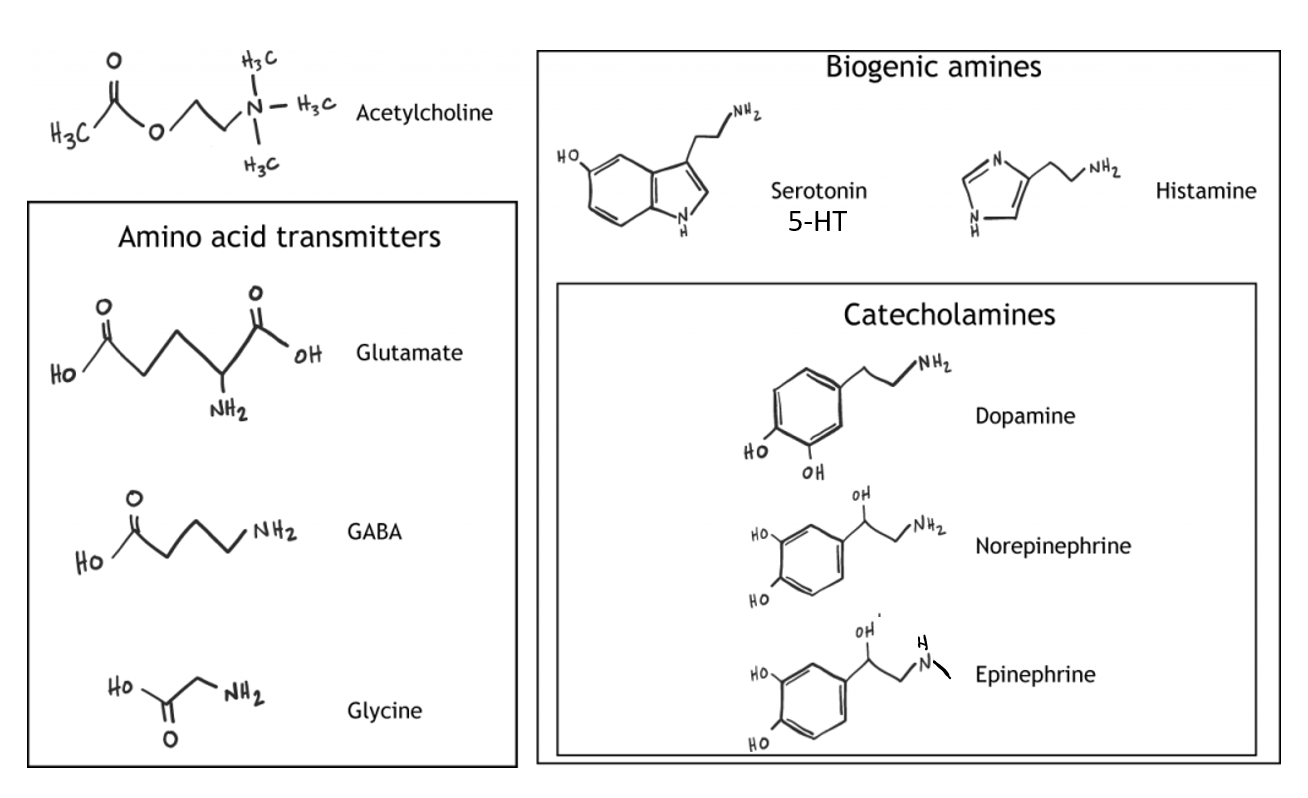
Synthesis and Storage of Small Molecule Transmitters
Most small molecule neurotransmitters are synthesized by enzymes that are located in the cytoplasm (the exception is norepinephrine, see below). This means that small molecule neurotransmitters can be synthesized and packaged for storage in the presynaptic terminal using enzymes present in the terminal.
Acetylcholine
Acetylcholine is best known for its role at the neuromuscular junction, the synapse between a motor neuron and the muscle fiber. In the presynaptic terminal, acetylcholine is synthesized from acetyl coenzyme A (acetyl CoA) and choline via the enzyme choline acetyltransferase. The level of enzyme activity is the rate-limiting step in the synthesis pathway. Acetylcholine is packaged into vesicles for storage in the terminal via the vesicular acetylcholine transporter (VAChT).
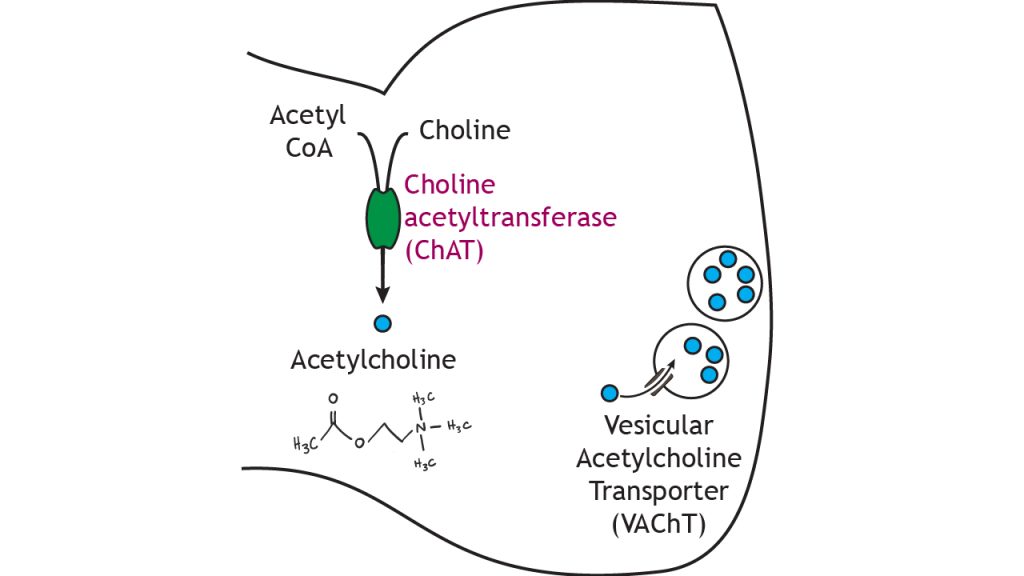
Glutamate
Glutamate is an amino acid transmitter and is the primary excitatory neurotransmitter in the brain. In the presynaptic terminal, glutamine is converted into glutamate via the enzyme glutaminase, which is the rate-limiting step in the synthesis pathway. Glutamate is packaged into vesicles for storage via the vesicular glutamate transporter.
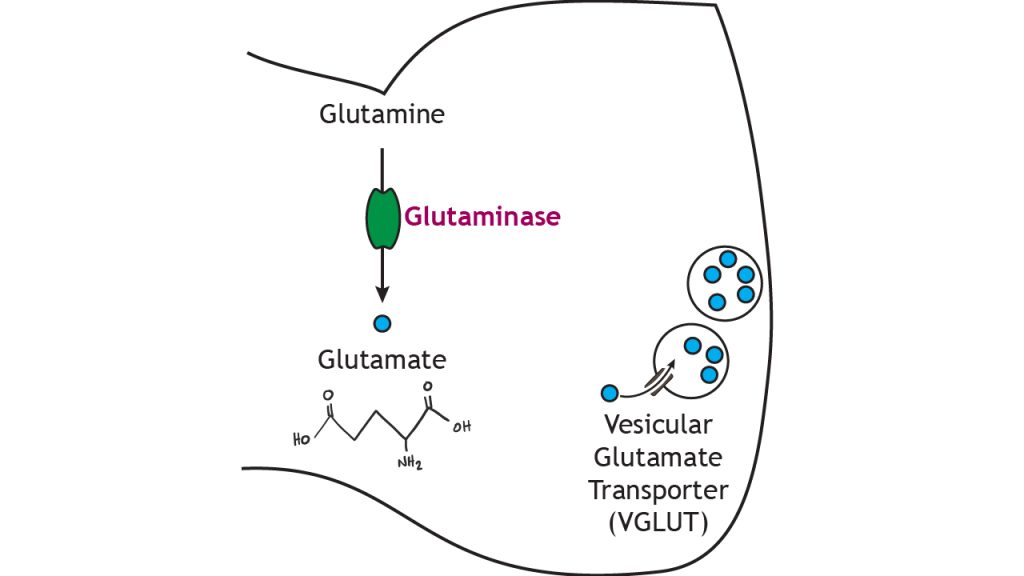
GABA
Glutamate is then used to synthesize GABA, another amino acid transmitter and the primary inhibitory neurotransmitter in the brain. In the presynaptic terminal, glutamate is converted into GABA via the enzyme glutamic acid decarboxylase, which like the other synthesis pathways is the rate-limiting step. GABA is packaged into vesicles for storage in the terminal via the vesicular inhibitory amino acid transporter.

Glycine
Glycine is another inhibitory amino acid neurotransmitter, but unlike GABA, it is more common in the spinal cord than in the brain. Serine hydroxymethyltransferase converts the amino acid serine into glycine in the presynaptic terminal. The rate limiting step for glycine synthesis occurs earlier in the pathway prior to serine synthesis. Glycine is packaged into vesicles by the vesicular inhibitory amino acid transporter like GABA.
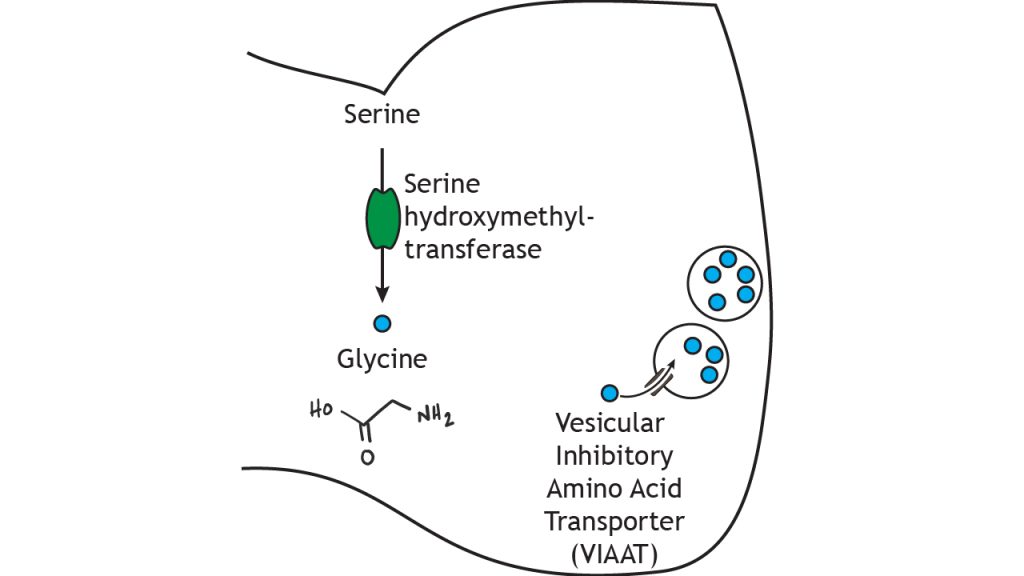
Dopamine
Dopamine, a catecholamine transmitter, plays many roles in the nervous system, but it is best known for its roles in reward and movement. In the presynaptic terminal, the amino acid tyrosine is converted into DOPA via tyrosine hydroxylase, which is the rate limiting step in the synthesis of all the catecholamines. DOPA is then converted to dopamine by DOPA decarboxylase. Dopamine is packaged into synaptic vesicles by the vesicular monoamine transporter.
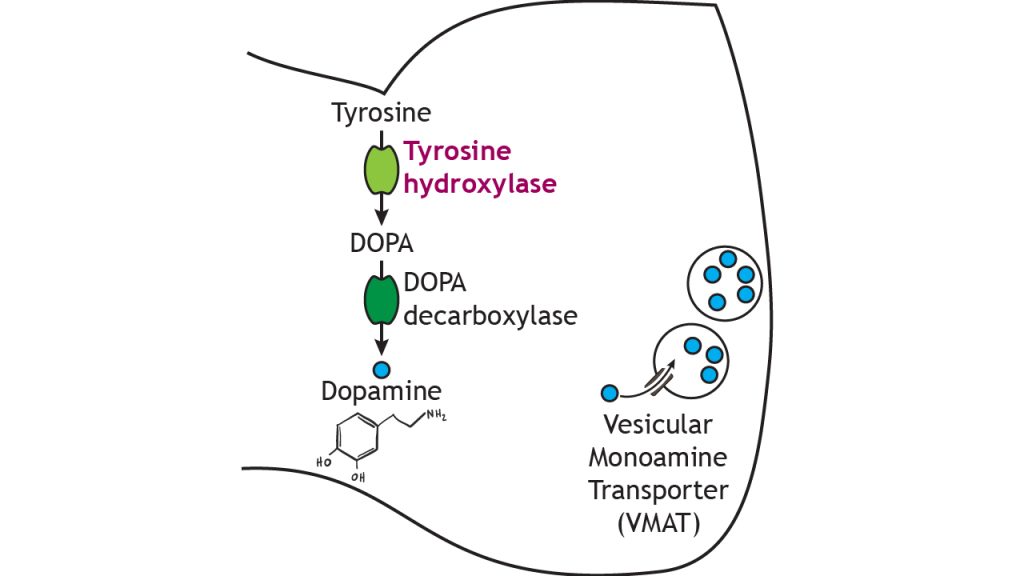
Norepinephrine
In neurons that release norepinephrine, which is another catecholamine transmitter, once dopamine is packaged into the synaptic vesicles, a membrane-bound enzyme called dopamine beta-hydroxylase converts dopamine into norepinephrine. Therefore, unlike the other small molecule neurotransmitters, norepinephrine is synthesized within the vesicles, not in the cytoplasm. Like dopamine, the rate limiting step of this synthesis pathway is the activity of tyrosine hydroxylase.
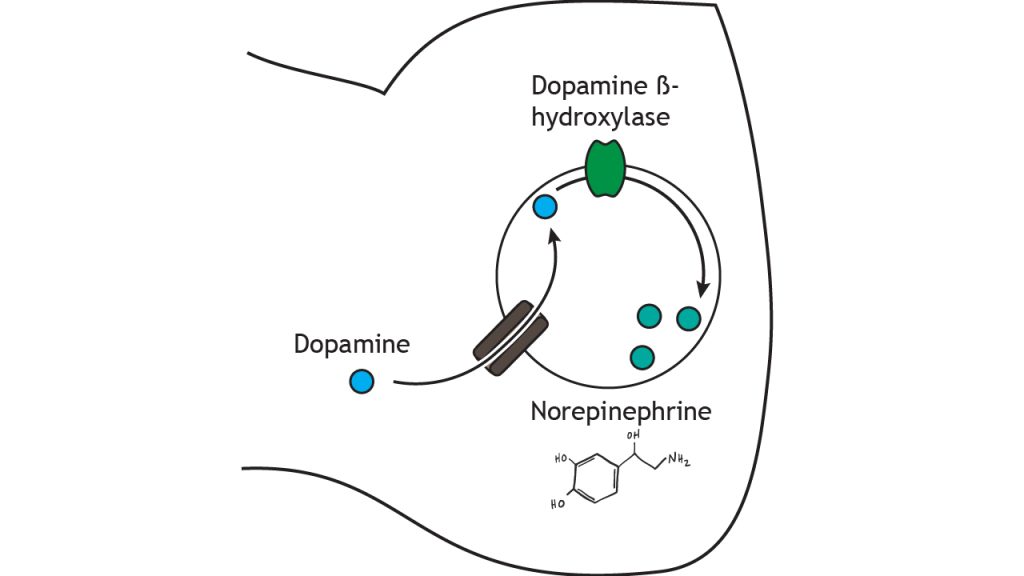
Epinephrine
Epinephrine, also called adrenaline, is a catecholamine, but it is often considered a hormone instead of a neurotransmitter. Epinephrine is primarily released by the adrenal medulla into the circulation; it is used as a neurotransmitter in only a small number of neurons. Epinephrine is synthesized from norepinephrine in the cytoplasm by the enzyme phenylethanolamine-N-methyltransferase, so epinephrine synthesis requires norepinephrine to exit the vesicles where it was synthesized. After synthesis in the cytoplasm, epinephrine is repackaged into vesicles via the vesicular monoamine transporter.
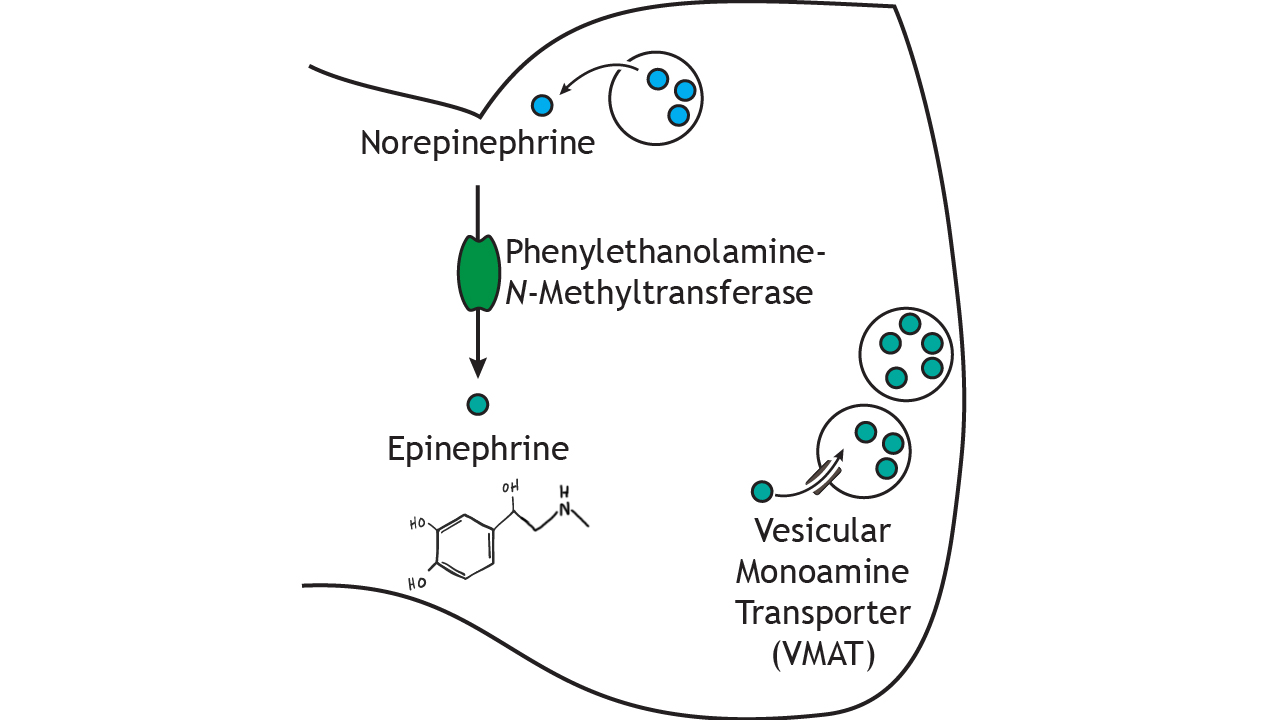
Serotonin
Serotonin, a biogenic amine neurotransmitter, is known for its role in mood. Tryptophan is converted into 5-hydroxytryptophan by tryptophan hydroxylase. This is also the rate-limiting step of the synthesis pathway. Then aromatic L-amino acid decarboxylase converts the 5-hydroxytryptophan into serotonin. Serotonin is packaged into vesicles by the vesicular monoamine transporter similar to the other monoamine neurotransmitters: dopamine and epinephrine.
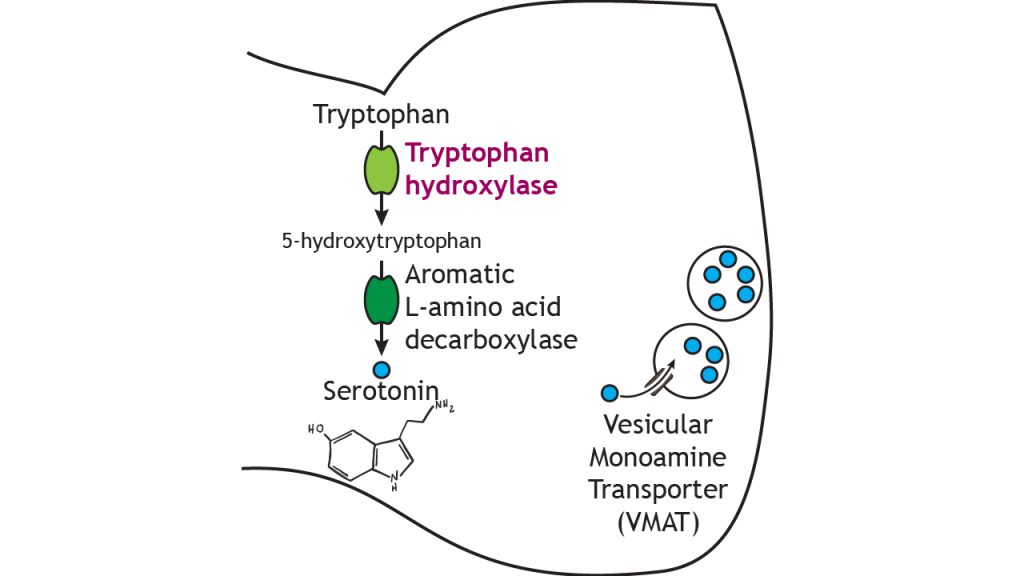
Histamine
Finally, histamine is another biogenic amine transmitter that is synthesized from histidine through the action of histadine decarboxylase, the rate limiting step of the pathway. Like the other monoamine neurotransmitters, it is packaged into synaptic vesicles via the vesicular monoamine transporter.
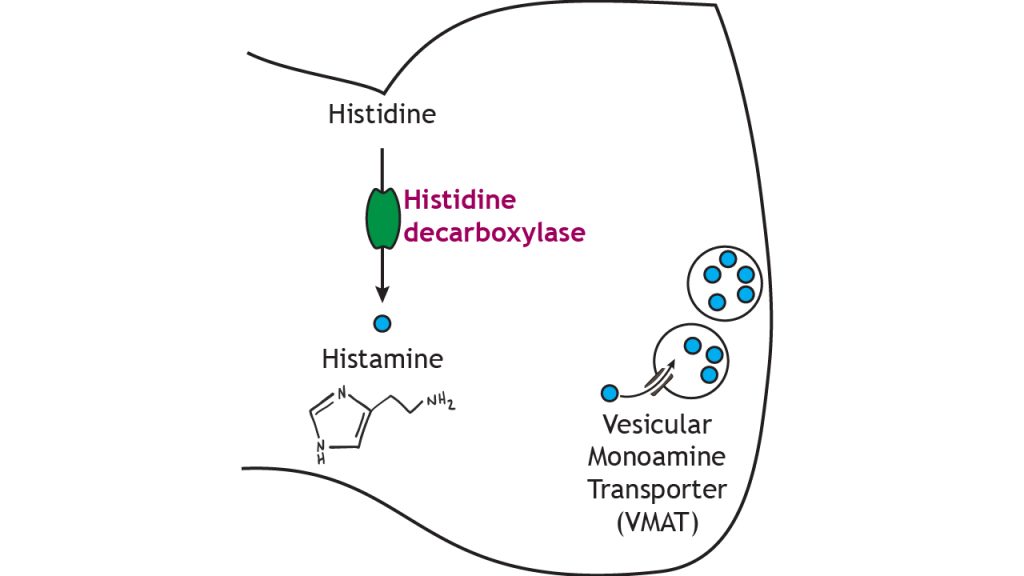
Synthesis and Storage of Neuropeptides
Neuropeptides are synthesized in the cell body and transported to the synaptic terminal
Neuropeptides are a short string of amino acids and are known to have a wide range of effects from emotions to pain perception. Unlike small molecule neurotransmitters, neuropeptides are synthesized in the cell body and transported to the axon terminal. Like other proteins, neuropeptides are synthesized from mRNA into peptide chains made from amino acids. In most cases, a larger precursor molecule called the prepropeptide is translated into the original amino acid sequence in the rough endoplasmic reticulum. The prepropeptide is processed further to the propeptide stage. The remaining processing and packaging of the final neuropeptide into a vesicle occurs in the Golgi apparatus. The peptides are packaged into vesicles that are significantly larger that the vesicles that store the small molecule transmitters. These large vesicles must then move from the soma to the terminal.
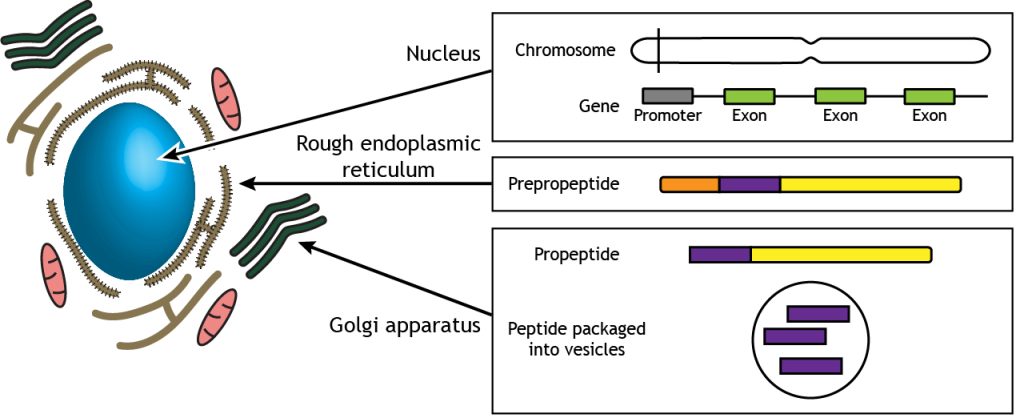
Axonal Transport
The packaged peptides need to be transported to the presynaptic terminals to be released into the synaptic cleft. Organelles, vesicles, and proteins can be moved from the cell body to the terminal via anterograde transport or from the terminal to the cell body via retrograde transport. Anterograde transport can be either fast or slow.
The packaged neuropeptides are transported to the synaptic terminals via fast anterograde axonal transport mechanisms.
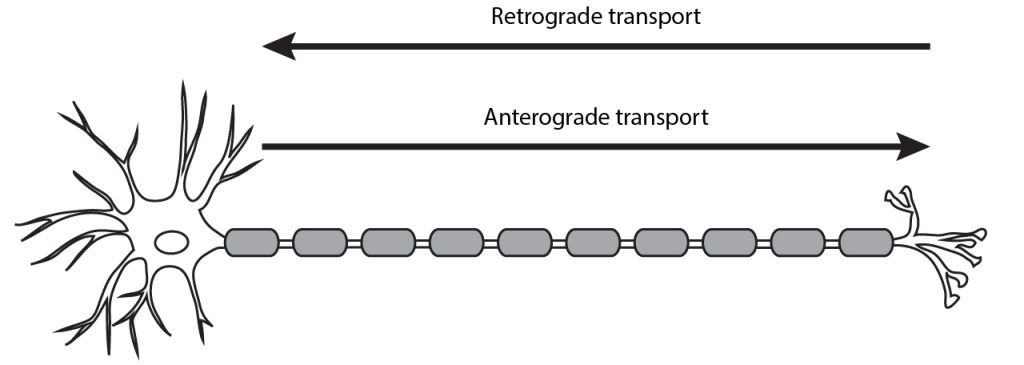
Key Takeaways
- Small molecules neurotransmitters are synthesized and packaged into vesicles in the presynaptic terminal
- Neuropeptide transmitters are synthesized and packaged into vesicles in the cell body and are transported to the terminal via fast axonal transport
- Each small molecule neurotransmitter has a rate limiting step that controls the rate of synthesis
- Neuropeptides rely on axonal transport mechanisms to move from the soma to the terminal
Test Yourself!
Try the quiz more than once to get different questions!
- For each neurotransmitter below, which enzyme is responsible for the rate-limiting step in the synthesis pathway, which enzyme is responsible for the final step of the synthesis pathway, and which enzyme is responsible for packaging of the transmitter into vesicles
- Acetylcholine
- Glutamate
- GABA
- Glycine
- Dopamine
- Norepinephrine
- Epinephrine
- Serotonin
- Histamine
Video Lecture
Attributions
This chapter was adapted from “Neurotransmitter Synthesis and Storage” in Foundations of Neuroscience by Casey Henley which is licensed under a Creative Commons Attribution NonCommerical ShareAlike 4.0 International License.

